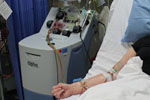 I have compound heterozygous FH which means both my parents have FH and both passed their FH gene onto me. The chances of this are 1 in 300,000 to 1 in 1,000,000. Untreated compound heterozygous people usually have heart disease by their 20s. Luckily I’ve had treatment and I have been on a low fat diet from a young age.
I have compound heterozygous FH which means both my parents have FH and both passed their FH gene onto me. The chances of this are 1 in 300,000 to 1 in 1,000,000. Untreated compound heterozygous people usually have heart disease by their 20s. Luckily I’ve had treatment and I have been on a low fat diet from a young age.
It all started when I was about 2 years old. I started to develop orange lumps on my hands, elbows, knees and Achilles tendon. I was taken to my GP who had never seen anything like the orange lumps before and thought it was ‘something in my system which was coming out on my body’. My GP suggested I see a dermatologist who then referred me to a doctor at Royal Perth Hospital. He diagnosed these lumps as xanthomas and diagnosed my very high cholesterol (around 25 mmol/L).
I was put on a very low fat diet and prescribed Questran, nicotinic acid and Clofibrate. This was in the early seventies and these were the only medications available for reducing cholesterol. As a child I remember not liking the Questran (bile acid binding resin). I refused to take it and as a result it used to thicken and it became even more unpalatable as it sat there on the kitchen bench!
At the age of 9, I had a partial ileal bypass. In this operation the final part of the small intestine (ileum) is cut and attached to the large intestine (colon). As a result, intestinal contents bypass the last third of the ileum, the site of most of the absorption of cholesterol and bile acids. Thus, the operation leads to a reduction in cholesterol levels. Diarrhoea, kidney stones and gallstones are the most common side effects of ileal bypass. While in the UK, in my 20s, I developed jaundice and B12 anaemia (the body needs vitamin B12 to produce red blood cells) which is common after this type of surgery. I was hospitalised for a week and had a Schilling test by bone marrow aspiration and biopsy to confirm my B12 deficiency. I now have quarterly B12 injections.
Around puberty, my xanthomas started to disappear, but in my 20s I started to get xanthelasma under my eyes and on my eye lids.
When DNA testing was started, relatives on both sides of my family had their specific DNA mutations confirmed. My mum has one type of gene mutation and my dad has a different type of gene mutation which causes compound heterozygous FH.
Every new treatment or medication that comes along, I put my hand up to try it. I was put on statins as soon as they came on to the market in the late 1980s. I trialled Ezetimibe in the early 2000s and it was successful and this was added to my medication regimen.
Around 10 years ago lipoprotein apheresis was started in Perth and I was one of the first people in Australia to have the procedure. This procedure gives me near normal LDL levels. I attend hospital on a weekly basis to have the procedure carried out and require half a day off work. I often feel tired after the procedure. After initial testing of the procedure, in 2004 I had a fistula created in my forearm. A fistula is where an artery is joined to a vein causing the vein to grow large and strong. Having a fistula means veins are able to withstand the regular needle insertions which apheresis requires.
Recently, I was involved in a PCSK9 inhibitor trial but it was not successful as I have too few functioning LDL receptors. Since being on lipoprotein apheresis, the xanthelasma under my eyes have practically disappeared. When I was on the PCSK9 trial drug, it caused the xanthelasma under my eyes to reappear.
There are lots of new medications coming onto the market and I am about to start trialling another one.
I am in my mid 40s now and have not had a heart attack. I remain hopeful that one of the new treatments will work for me, meanwhile I know lipoprotein apheresis, although very intrusive in my life, is keeping my LDL levels (with the help of statins and a very strict low fat diet) at near normal levels.
